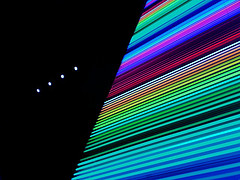 For a long time physicists thought it was impossible to see anything smaller than about half the wavelength of light.
For a long time physicists thought it was impossible to see anything smaller than about half the wavelength of light.
That’s true if you look at the propagating component of light waves. But light also records smaller sub-wavelength details in its evanescent components, which do not propagate. At least not usually. What [John] Pendry showed [about 10 years ago] was that evanescent components can propagate in a material with a negative refractive index, and he pointed out that a thin film of silver ought to have just the right properties.
Since then, the race has been on to build superlenses. In 2005, Nicolas Fang at the University of Illinois at Urbana-Champaign created one that could record details as small as one-sixth of a wavelength. That was a significant improvement over the diffraction limit, but why not better?
Fang and company recently achieved resolution of only one-twelfth the wavelength of light. The theoretical limit is now pegged at one-twentieth a wavelength, which should be small enough to watch molecules in motion.
The impact of such “transparency” on the micro level opens up fertile realm for speculation: Surely drug designers, among others, are going to want superlenses of their own.
[Story: Technology Review physics arXiv blog; thanks for the tip, dpodolsky; London neon sculpture photo: clry2]